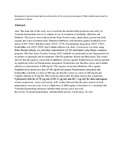Evaluation of antimicrobial activity and toxicity of Vernonia hymenolepis (A. Rich) traditionally used for toothache in Kenya

View/
Date
2014Author
Kiama, Stephen Gitahi
Type
ThesisLanguage
enMetadata
Show full item recordAbstract
The main aim of the study was to ascertain the antimicrobial properties and safety of Vernonia hymenolepis leaves to validate its use in treatment of toothache. Materials and Methods: The Leaves were collected from Trans Nzoia County, shade dried, ground and both organic and water extraction done. Minimum inhibitory concentration against Staphylococcus aureus ATCC 25923, Bacillus cereus ATCC 11778, Pseudomonas aeruginosa ATCC 27853, Escherichia coli ATCC 25922 and Candida albicans was done. Cytotoxicity was done using Brine Shrimp lethality test and lethal concentration (LC50) determined using Finney computer program. The Oral Acute Toxicity Testing (ATC method) was performed as per Organization for economic co-operation and development (OECD) guideline. Result and Discussion: The results showed that the aqueous extract had an inhibitory activity against Staphylococcus aureus and had no significant effect on Pseudomonas aeruginosa, Escherichia coli, Bacillus cereus and Candida albicans at concentration of 400 mg/ml. The organic extract had inhibitory effect against Staphylococcus aureus at a dose of 100 mg/ml and against Pseudomonas aeruginosa and Escherichia coli both at a dose of 400 mg/ ml, Bacillus cereus at a dose of 200 mg/ml and Candida albicans at 50 mg/ml. This study has shown that the plant extracts has a moderate Cytotoxicity with the LC50 (μg /ml) of 491.8 (μg /ml) and 481.7 (μg /ml) for water and organic extract respectively. Acute oral toxicity ATC method showed that the plant extracts in both preparations were not toxic even at a high dose of 2000 mg/kg. Conclusion: It’s concluded that Vernonia hymenolepis possesses antimicrobial activity and is not toxic.
Keywords: Vernonia hymenolepis, Antimicrobial activity, Cytotoxicity, In-vitro.
Publisher
University Of Nairobi
